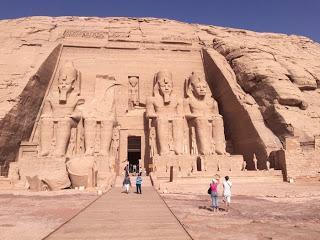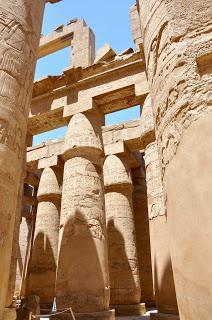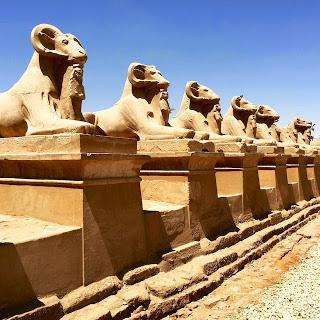 As I mentioned in a previous post, the most iconic symbol of Egypt is without a doubt the Pyramids and Sphinx at Giza. Who amongst us hasn't been memorized by images of those massive structures that have stood for more than 4500 years atop a plateau that overlooks what is now modern Cairo. Those immense tombs built as monuments to the Pharos Khufu, Khafre, and Menkaure live up to their billing, inspiring an overwhelming sense of awe in those who stand in their shadows. There is a reason why the Great Pyramid is considered one of the Seven Wonder of the Ancient World, and it is more than evident when you stand beside it. But those amazing buildings aren't the only impressive structures to be found in Egypt. In fact, the country is filled with other temples, tombs, and statues that are impressive in their own right. Some of them even rival the Pyramids in terms of grandeur.
As I mentioned in a previous post, the most iconic symbol of Egypt is without a doubt the Pyramids and Sphinx at Giza. Who amongst us hasn't been memorized by images of those massive structures that have stood for more than 4500 years atop a plateau that overlooks what is now modern Cairo. Those immense tombs built as monuments to the Pharos Khufu, Khafre, and Menkaure live up to their billing, inspiring an overwhelming sense of awe in those who stand in their shadows. There is a reason why the Great Pyramid is considered one of the Seven Wonder of the Ancient World, and it is more than evident when you stand beside it. But those amazing buildings aren't the only impressive structures to be found in Egypt. In fact, the country is filled with other temples, tombs, and statues that are impressive in their own right. Some of them even rival the Pyramids in terms of grandeur.After spending the first day of my recent trip to Egypt in Cairo, where the Pyramids were definitely the highlight of the experience, I took an overnight train south to Aswan, a city that is well known for a decidedly more modern architectural wonder. It is here that a massive project was undertaken back in the 1960's to build a dam across the Nile. This dam provided the ability to control the river to a degree, preventing seasonal flooding that would destroy farms and villages along the banks of the famous river. That dam is now vital to the economy of the country, and its construction was quite a feat of modern construction back in the day.
Aswan is also the gateway to the deep south, where one of the most impressive monuments to ancient Egypt sits just a short distance away from the border with Sudan. The temples at Abu Simbel were built to commemorate the reign of Ramses II, the greatest Pharaoh in Egyptian history, as well as his wife Nefertari. These structures feature massive stone statues that were intricately carved out of rock faces depicting Ramses taking his place with the ancient gods that were worshipped throughout the country. He ordered the construction of the temples following his great victory at the Battle of Kadesh, during which Ramses defeated an army of Hittites in what may have been the largest chariot battle ever fought. It's location along the southern border of the Egyptian empire was to serve as a warning to invaders from Africa, and a testament to the power of the Pharaoh himself.
Abu Simbel has always been a popular attraction for travelers, although it is quite a trek out to the desert just to see it. It sits 300 km (186 miles) to the south of Aswan, in a remote region far from any other sites. The current home of the two temples wasn't where it originally stood either, which makes its location all the more curious. When the Aswan Dam was being built in the 60's, the temple had to relocated in its entirety, an effort that took hundreds of workers and cost millions of dollars. That undertaking was more than worth it however, as the site is one of the most impressive in all of Egypt, and it a fantastic look at what Egyptian craftsmen were able to accomplish thousands of years ago.
Walking inside the twin temples reveals well preserved paintings, statues, and chambers. While over the years some of the luster has worn off, there are still numerous places where visitors can catch a glimpse of what the place must have looked like when it was in its full glory. We can only imagine what this place must have looked like when it was first built, as it is magnificent even now.
Back in Aswan there is plenty of things for visitors to do as well. The Temple of Kalabsha is another great example of Egyptian architecture, and a well-stocked market is worth a stroll, provided you can put up with aggressive shopkeepers hawking their wares. The city is also a great place to take a sail aboard a traditional Nubian sailing ship known as a fulluca. Spending a few hours on the Nile River is a relaxing way to take in the daily life of those that live there, as is visit to nearby Nubian village, which gives you a look at a very different culture that has existed within Egypt for thousands of years.
A visit to Aswan at the moment also provides insight into just how few visitors are currently coming to Egypt. All along the river there are massive cruise ships moored to the docks just waiting for a large enough contingent of travelers to make the traditional cruise down the Nile. These boats have so few customers at the moment that it isn't even worth it for them to set sail. Dozens of them line the banks of the river, silent, empty, and unused. In time, I'm sure they'll be pressed back into service as travelers return to the country, but for now they are a sad reminder of just how hard the Egyptian tourism sector has been hit.
 After a few days in Aswan, I moved north along the Nile to the city of Luxor, which was once known as Thebes in the ancient world. The city was originally built to honor the god Amon-Ra, and as such there are a number of major temples and other monuments to be found there. In fact, the entire city seems like an open-air museum, with ancient wonders to be found around every corner.
After a few days in Aswan, I moved north along the Nile to the city of Luxor, which was once known as Thebes in the ancient world. The city was originally built to honor the god Amon-Ra, and as such there are a number of major temples and other monuments to be found there. In fact, the entire city seems like an open-air museum, with ancient wonders to be found around every corner.Not the least of those wonders is the incredible Temple of Karnak. This sprawling site is one of the largest religious structures ever built, dwarfing even places like the Vatican and Hagia Sophia in Turkey. Karnak was a site so important to the ancient Egyptians that numerous pharos continued to add chapels, obelisks, statues, and chambers over the centuries. All of that construction can give it a bit of a disjointed feel at times, but it is still an incredibly fascinating and impressive place none the less. Visitors could spend the better part of a day wandering through its halls, and probably still wouldn't see everything that the temple has to offer. One of the biggest highlights for me personally were the massive pillars of the Great Hypostyle Hall, which began being built under Seti I, but were finished by Ramses II. There are 134 columns in all, spread out over two different room. Each stands 24 meters (80 feet) in height, and are 10 meters (33 feet) in circumference. Wandering amongst them is akin to walking through a stone forest, with intricately carved trees surrounding you on all sides.
Across town from the Temple of Karnak is Luxor Temple, which would be incredibly impressive in any other location, but suffers a bit in comparison to its larger companion. Still, this temple is an incredible one, with massive stone statues, more towering pillars, and plenty of great examples of ancient Egyptian craftsmanship that are unique to the site. Best of all, in the evening, the temple is lit up by a series of lights, which make it truly stand out in the center of the city. Strolling past the sandstone structures in the darkness is a wonderful way to appreciate the setting, and is a must-do for any visitor.
 One of the more lesser known wonder of Luxor is one that is still being excavated. The Avenue of the Sphinxes is a road that runs between Karnak and Luxor temples that is lined with statues of the sphinx. So far, about 3.1 km (1.9 miles) of the road has been uncovered, with over 1000 individual statues being restored. Those statues fall every few meters along the route, and are amazing in their own right. Again, what it must have been like to have seen these two amazing sites in their full glory, connected by a special road lined with statues.
One of the more lesser known wonder of Luxor is one that is still being excavated. The Avenue of the Sphinxes is a road that runs between Karnak and Luxor temples that is lined with statues of the sphinx. So far, about 3.1 km (1.9 miles) of the road has been uncovered, with over 1000 individual statues being restored. Those statues fall every few meters along the route, and are amazing in their own right. Again, what it must have been like to have seen these two amazing sites in their full glory, connected by a special road lined with statues.I am thankful that on my trip I was able to spend time in these amazing locations. The itinerary that was set up for me by friends at G Adventures offered ample time to truly appreciate the ancient wonder of Egypt, and soak in the culture and history of these places. But my journey wasn't a special one set up specifically to show off these sites to someone who could write about it. It was part of G's Absolute Egypt trip, which is affordable and accessible to anyone who has a desire to visit the country for themselves. On that journey, not only will you get to see all of the things that I have shared so far, but many other wonders that I have yet to share. It is an all encompassing option that deftly mixes the ancient wonders of Egypt, with the natural beauty of the Sahara Desert.
More to come soon. I hope you are enjoying the account of my trip so far.

